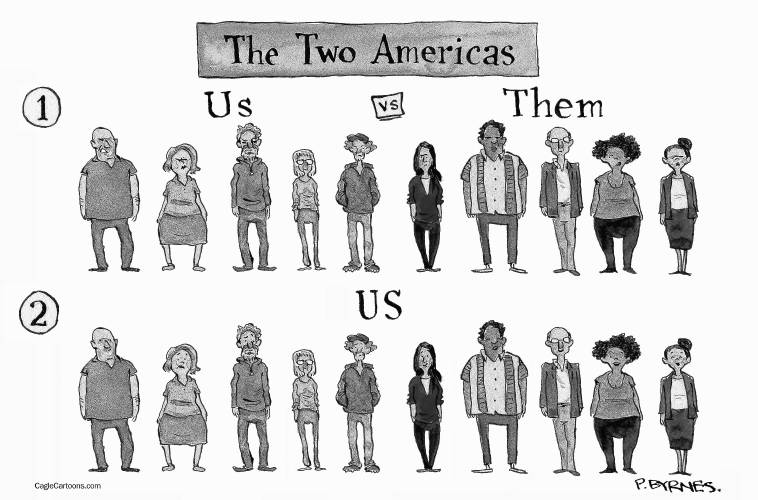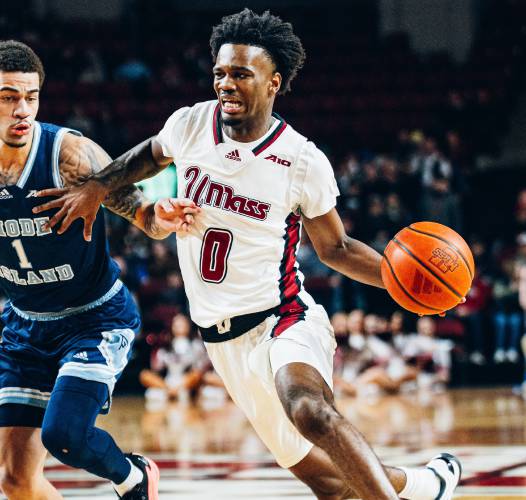Latest News

Putting themselves on the line: Activists say nonviolent protests focus attention, inspire others, drive change
Valley residents have been witnessing growing numbers of their neighbors standing out in the rain, wind and cold toting colorful signs and passionate messages.

USDA yanks $3.4M in aid to state food banks
NORTHAMPTON — A decision by the U.S. Department of Agriculture to terminate a $3.4 million allocation to Massachusetts for purchase of 121,830 cases of food items, including eggs, chicken, milk, fruit, pasta, beans and salmon for food banks across the state is being criticized by representatives of food security organizations and the Healey-Driscoll administration.
Most Read
 Northampton Housing Authority boss placed on leave
Northampton Housing Authority boss placed on leave
 NCAA Div. 1 Men’s Ice Hockey: UMass stuns Minnesota 5-4 in OT, advances to regional final
NCAA Div. 1 Men’s Ice Hockey: UMass stuns Minnesota 5-4 in OT, advances to regional final
 UMass Men’s Basketball: Three Minutemen enter transfer portal
UMass Men’s Basketball: Three Minutemen enter transfer portal
 Easthampton schools adopt $22.8M budget with no layoffs; enrollment decline, student needs a concern
Easthampton schools adopt $22.8M budget with no layoffs; enrollment decline, student needs a concern
 Area property deed transfers, March 28
Area property deed transfers, March 28
 Fire ravages Lincoln Street home in Holyoke
Fire ravages Lincoln Street home in Holyoke
Editors Picks
 Area briefs: Mount Holyoke’s Trailblazers of Color conference; Holyoke Library to host annual mini golf and games; Westfield State launches paramedic program
Area briefs: Mount Holyoke’s Trailblazers of Color conference; Holyoke Library to host annual mini golf and games; Westfield State launches paramedic program
 Photo: Budding artists to sell wares at UMass show
Photo: Budding artists to sell wares at UMass show
 Arts Briefs: Opportunities for local creatives, All Hamptons Read, Jewish Film Fest, and more
Arts Briefs: Opportunities for local creatives, All Hamptons Read, Jewish Film Fest, and more
 Historic speech echoes two centuries later: ‘A Light Under the Dome’ recalls the first American woman to speak to a legislative body
Historic speech echoes two centuries later: ‘A Light Under the Dome’ recalls the first American woman to speak to a legislative body
Sports

UMass hockey: Minutemen fall to Western Michigan, 2-1, in Fargo Regional final
The UMass hockey team’s season came to a close in its 2-1 loss to Western Michigan during the Fargo Regional final of the NCAA Tournament on Saturday night in Fargo, North Dakota.
Opinion

Guest columnist Donald Joralemon: First, they came for the idea of the common good
 Rosemary Seifert-Graf: We must protect IMLS
Rosemary Seifert-Graf: We must protect IMLS
 Marc Warner: Mayoral competence? Look at results
Marc Warner: Mayoral competence? Look at results
 Bob Gardner: In defense of Hatfield Housing Board member
Bob Gardner: In defense of Hatfield Housing Board member
 Douglas Amy: Undocumented immigrants' contributions
Douglas Amy: Undocumented immigrants' contributions

Your Daily Puzzles

An approachable redesign to a classic. Explore our "hints."

A quick daily flip. Finally, someone cracked the code on digital jigsaw puzzles.

Chess but with chaos: Every day is a unique, wacky board.

Word search but as a strategy game. Clearing the board feels really good.

Align the letters in just the right way to spell a word. And then more words.
Business

Consumer Corner with Anita Wilson: Spam texts a growing threat to consumers
Have you gotten a text message saying you owe money for unpaid tolls?
 Spreading the Mexican spice: After five years in Florence, Masa Mexicano spreads its wings with second location in Belchertown
Spreading the Mexican spice: After five years in Florence, Masa Mexicano spreads its wings with second location in Belchertown
 Area property deed transfers, March 28
Area property deed transfers, March 28
 Making News in Business, March 28
Making News in Business, March 28
Arts & Life

‘His notes will linger forever’: Remembering Young@Heart accordionist and Springfield College professor Chris Haynes
Chris Haynes, longtime accordionist for the Young@Heart Chorus and associate professor emeritus of music at Springfield College, died on Wednesday, March 12.
Obituaries
 Nancy Anson
Nancy Anson
Nancy (Otte) Anson NORTHAMPTON, MA - Nancy Otte Anson of Northampton, Massachusetts, left the world on Monday, March 24, 2025. She was born March 22, 1955, in Cherokee, Iowa, to Norita (Sholly) and Evan Otte. Nancy and her sister, Susan,... remainder of obit for Nancy Anson
 Dawn Susanne Gavin
Dawn Susanne Gavin
Brewster, MA - Susanne (McPeck) Gavin, also known as "Auntie Sue," to those who knew her, passed away in Hospice care in Brewster, Massachusetts, at the age of 89. A native of Boston, she was born to John and Thelma (Shaw) McPeck. Susan... remainder of obit for Dawn Susanne Gavin
 Barbara Anne Murnane
Barbara Anne Murnane
Barbara Anne "Barb" Murnane Leeds, MA - Barbara Anne "Barb" Murnane died peacefully in her sleep at Linda Manor in the early morning hours of March 24, 2025. She was 97. Born on July 25, 1927 in Somerville, MA to John D. and Jessie Polle... remainder of obit for Barbara Anne Murnane
 Eugenia W. Herbert
Eugenia W. Herbert
Eugenia W. ("Fi") Herbert South Hadley, MA - EUGENIA W. HERBERT, Historian of Africa and South Asia Eugenia "Fi" Herbert died peacefully on March 10, 2025, surrounded by her family and friends. Fi was 95. Following her graduation from ... remainder of obit for Eugenia W. Herbert

 Hopeful buyers emerge for Magic Wings butterfly conservatory in South Deerfield
Hopeful buyers emerge for Magic Wings butterfly conservatory in South Deerfield
 NCAA Div. 3 Women’s Ice Hockey: Amherst downs Middlebury 3-1, reaches national title game
NCAA Div. 3 Women’s Ice Hockey: Amherst downs Middlebury 3-1, reaches national title game
 Ready to roll on roads: Amherst priority list tees up $4.55M to rebuild some of town’s worst stretches
Ready to roll on roads: Amherst priority list tees up $4.55M to rebuild some of town’s worst stretches
 Showdown looms over Northampton school budget
Showdown looms over Northampton school budget
 Winds whip Goshen brush fire caused by illegal burning
Winds whip Goshen brush fire caused by illegal burning
 Williamsburg’s ‘tired’ town office building on Main Street getting needed spruce up
Williamsburg’s ‘tired’ town office building on Main Street getting needed spruce up
 Amherst School Committee OK’s budget with no classroom layoffs, but spending plan is $500K more than town recommends
Amherst School Committee OK’s budget with no classroom layoffs, but spending plan is $500K more than town recommends
 Area briefs: Honoring Vietnam War vets on Saturday; Transhealth accepting new pediatric patients; Events for child abuse awareness month; Holyoke Sikh flag-raising
Area briefs: Honoring Vietnam War vets on Saturday; Transhealth accepting new pediatric patients; Events for child abuse awareness month; Holyoke Sikh flag-raising
 Legislation inspired by a Leverett family allows school bus monitoring systems
Legislation inspired by a Leverett family allows school bus monitoring systems
 H.S. Roundup: Hampshire softball scores five runs late, holds off Frontier 6-4 in season opener (PHOTOS)
H.S. Roundup: Hampshire softball scores five runs late, holds off Frontier 6-4 in season opener (PHOTOS) UMass Men’s Basketball: Three Minutemen enter transfer portal
UMass Men’s Basketball: Three Minutemen enter transfer portal NCAA Div. 1 Men’s Ice Hockey: UMass stuns Minnesota 5-4 in OT, advances to regional final
NCAA Div. 1 Men’s Ice Hockey: UMass stuns Minnesota 5-4 in OT, advances to regional final  High Schools: Hopkins softball opens season with 10-0 win over Granby (PHOTOS)
High Schools: Hopkins softball opens season with 10-0 win over Granby (PHOTOS) State pilot program puts restaurant takeout meals on food aid menus around region
State pilot program puts restaurant takeout meals on food aid menus around region Valley Bounty: And on that farm she had a bit of everything: Little Brook Farm in Sunderland is a labor of love for farmer Kristen Whittle
Valley Bounty: And on that farm she had a bit of everything: Little Brook Farm in Sunderland is a labor of love for farmer Kristen Whittle Women’s history told through clothing: Shelburne Falls Area Women’s Club to host ‘Real Clothes, Real Lives: 200 Years of What Women Wore’ author, April 9
Women’s history told through clothing: Shelburne Falls Area Women’s Club to host ‘Real Clothes, Real Lives: 200 Years of What Women Wore’ author, April 9 ‘A woman who should be remembered’: New play about the life of Frances Perkins, the brains behind FDR’s New Deal, April 5 and 11
‘A woman who should be remembered’: New play about the life of Frances Perkins, the brains behind FDR’s New Deal, April 5 and 11 Declutter your mind, with some help: Local author offers 201 prompts of ‘Fierce Encouragement’ to aspiring writers
Declutter your mind, with some help: Local author offers 201 prompts of ‘Fierce Encouragement’ to aspiring writers
